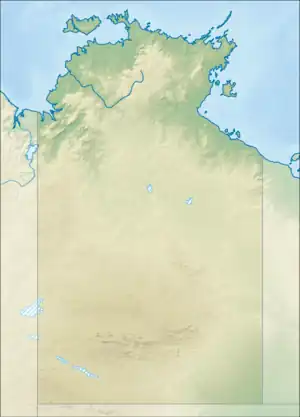Liverpool River
Liverpool River is a river in the Northern Territory of Australia. It is the largest of the tidal river systems of northern Arnhem Land, which includes two major tributaries, the Tomkinson and Mann Rivers.[2]
| Liverpool | |
|---|---|
 Location of the Liverpool River mouth in the Northern Territory | |
| Etymology | Lord Liverpool |
| Location | |
| Country | Australia |
| Territory | Northern Territory |
| Physical characteristics | |
| Source | |
| • location | Spencer Range, Arnhem Land, Australia |
| • elevation | 161 m (528 ft) |
| Mouth | |
• location | Australia |
• coordinates | 12°07′00″S 134°10′30″E |
• elevation | 0 m (0 ft) |
| Length | 138 km (86 mi) |
| Basin size | 8,280 km2 (3,200 sq mi) |
| [1] | |
Geography
The river rises at the eastern end of the Spencer Range and flows in a north-easterly direction, eventually discharging into the Arafura Sea south of Bat Island and to the south west of the Aboriginal Community of Maningrida. Its major tributaries are the Tomkinson and Mann Rivers.[2]
The estuary formed at the river mouth is tidal in nature and in near pristine condition.[3] The estuary at the river mouth occupies an area of 33.8 square kilometres (13 sq mi) of open water. It is tide dominated in nature with a tide dominated delta having single channel and is surrounded by an area of 60.8 square kilometres (23 sq mi) covered with mangroves.[4]
The river has a catchment area of 8,280 square kilometres (3,197 sq mi)[5] The catchment is wedged between the Goomadeer River catchment to the west, the Blyth River catchment to the east and the Roper River catchment to the south.[6] It has a mean annual outflow of 3,810 gigalitres (4.983×109 cu yd),[7]
History
The river was named by explorer Phillip Parker King in 1818,[8] who named it after the British Prime Minister, Robert Banks Jenkinson, 2nd Earl of Liverpool, otherwise known as Lord Liverpool.
The Liverpool River area was recommended by the explorer Capt. Francis Cadell, following his explorations of 1867–68, as the most likely area in the Top End to succeed as a centre of agriculture and livestock production, and as the site for a capital city.[9] Less than a year later George Goyder and his 100 men were hard at work, founding the city of Palmerston (present-day Darwin), some 500 km to the west.
References
- "Map of Liverpool River, NT". Bonzle Digital Atlas of Australia. Retrieved 18 May 2015.
- Thurtell, Lisa; Finlayson, Max; Yibarbuk, Dean; Storrs, Michael (1999). "The Blyth-Liverpool wetlands, Arnhem Land, Northern Australia" (PDF). Australian Government. Dept of Environment and Heritage. The Supervising Scientist. Retrieved 31 May 2019.
- "Australian Catchment, River and Estuary Assessment" (PDF). Natural Heritage Trust. 2002. Archived from the original (PDF) on 13 February 2014. Retrieved 2 May 2015.
- "Liverpool River, NT". Australian online Coastal Information. Commonwealth of Australia. Retrieved 24 May 2015.
- T. J. Schultz; S. A. Townsend; C. A. Edwards; P. L. Dostine (November 2002). "Water quality monitoring in the Mary River catchment" (PDF). Natural Heritage Trust. Archived from the original (PDF) on 29 March 2015. Retrieved 27 April 2015.
- "Drainage Divisions" (PDF). Commonwealth of Australia. 2005. Archived from the original (PDF) on 1 April 2015. Retrieved 9 May 2015.
- "Liverpool River" (PDF). TRaCK. 2009. Retrieved 12 May 2015.
- "Place Names Register Extract - Liverpool River". NT Place Names Register. Northern Territory Government. Retrieved 2 May 2015.
- "Mr. Tomkinson and the Northern Territory". South Australian Chronicle And Weekly Mail. Vol. XI, no. 526. South Australia. 5 September 1868. p. 6. Retrieved 26 June 2019 – via National Library of Australia.